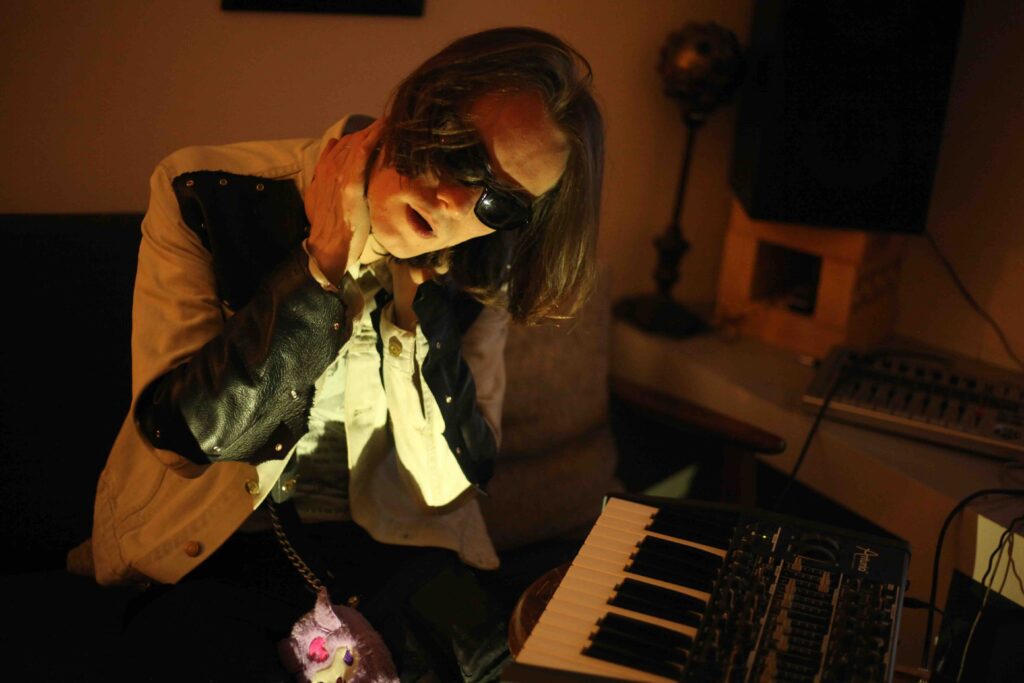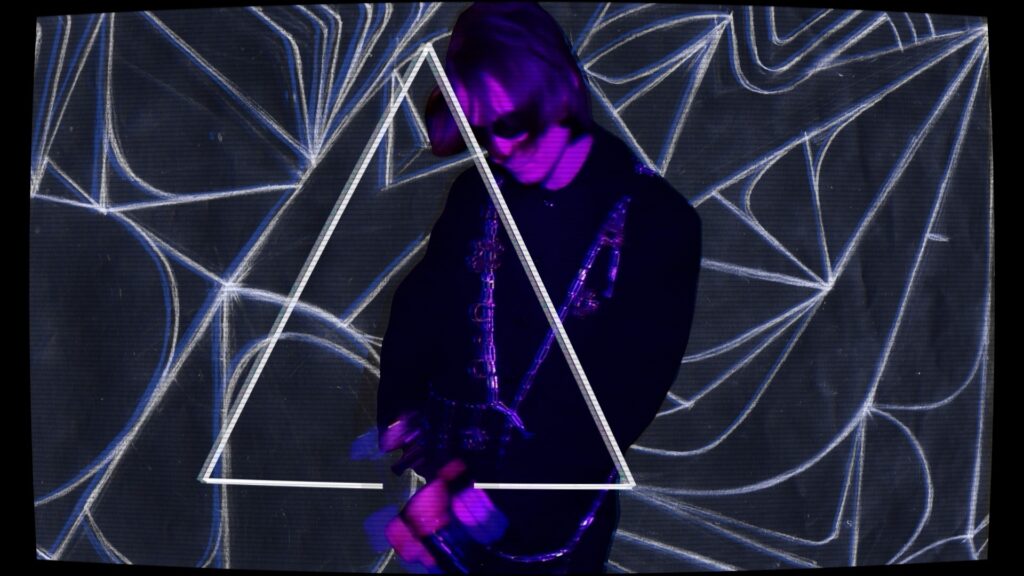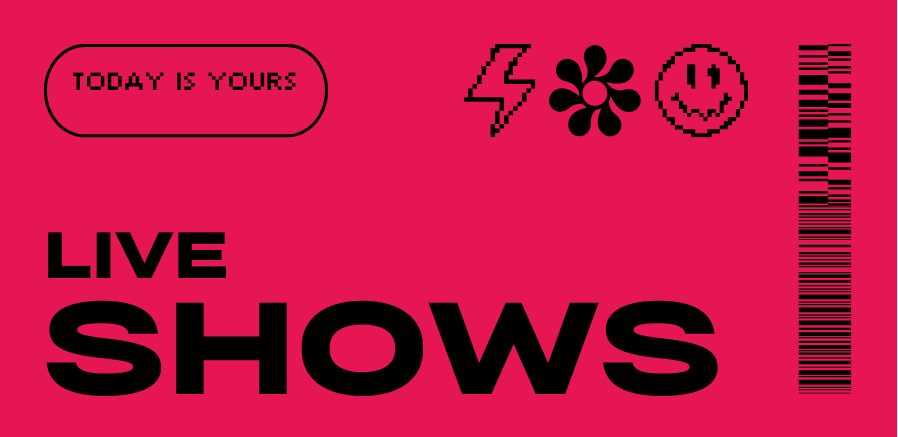‘Un Jour J’vais Die’ serves as our point of entry into Pragma Enigma’s haunting, hard-hitting artistic universe. As the project’s moniker implies, the Paris-based creative is a bit of an enigma, a committed and cathartic sonic explorer keen on becoming the new star of the French electro-rock scene. We’d argue that he has the potential to conquer the whole globe, not just his native France.
Featuring a visual livery that’s gloomy and daring, Pragma Enigma has conquered our attention with ‘Un Jour J’vais Die’, an eclectic piece that’s rather quirky and unique. Part synthwave, part industrial and part electro-rock, the record manages to be invaluable in club-oriented settings, as much as it is effective for a solo listening session. It’s malleable and sui generis, and we are not surprised that such a potent offering emerges from the curious mind of Pragma Enigma.
Intrigued by the project, we caught up with the French sonic alchemist to learn more about his artistry and future goals… interview below!
Hey Pragma, how is it going? Some of our readers might not be familiar with your project. How would you describe yourself, in a few words?
Hi, and thanks for the invite, I’m doing great! I’m Pragma Enigma. I make electronic music influenced by rock and trap. I live in Paris, creating a new genre that blends the sounds that inspire me. I use this music to vibrate matter and visualise it through my music videos, concerts, and art installations.
Your current work is the result of a long journey. What first drew you to making music?
Honestly, it wasn’t a conscious decision at first. I got my first real drum kit when I was a 10-month-old baby, and my dad, a composer, also introduced me to hard rock and grunge because I loved it. Later, I learned electric guitar and started rapping, but until I was 16, it was more of a hobby. At 17, I then discovered analogue synthesisers and piano; it was a revelation.
That’s when I really started studying music seriously. I dived deep into harmony and knew from that point on that this is what I wanted to do with my life. I could already hear a multitude of different compositions in my head, inspired by my dad’s music and everything I grew up on: hard rock, electro, trap, classical, and jazz.

I have peeked through your online presence, and I am hypnotised by your bold and futuristic aesthetic. What inspired the project’s strong visual component? Are there any artists or bands that helped you find the way forward?
Great question. I’m also a painter, and I’ve always had a strong attraction to colours and visual composition. It’s something instinctive for me and deeply connected to music. At first, I would “paint” my music with colours, shapes, and images that represented my compositions. That gradually evolved into a consistent visual identity.
Then I discovered Cymatics, the science of visualising sound through matter. That shifted everything. I stopped painting and started focusing on capturing how sound literally shapes physical materials. I began photographing and filming how vibrations affect the body during concerts, and how invisible sound waves create geometric patterns in different materials, and also in bodies during concerts.
It wasn’t really artists or bands that inspired this (except Kraftwerk or Dopplereffekt); it was my instincts and a fascination with synesthesia and the scientists working on this subject. That said, I’ve also been deeply inspired by certain films. My music videos are a continuation of my paintings and sonic visualisations, featuring a character I created who draws on the aesthetics of Eyes Wide Shut, A Clockwork Orange, Suspiria…
Let’s focus on your latest effort, ‘Un Jour J’vais Die’. It’s an intense, striking piece drenched in electro-pop and industrial tones. What was the idea behind the song, and what does the record mean to you?
The idea behind this song is quite fatalistic. The lyrics say clearly: we’re all going to die one day — it’s certain. But through accepting that inevitability, we can start to truly live for what we love and who we really are.
The message I wanted to convey is that when you fully commit to what you love and accept that you may die for it, that’s when you start to truly live it, to amplify it, even beyond your own limits. You break out of your comfort zone and stop living a life that frustrates you, where your dreams never materialise.
It’s about living your dreams now, with no compromise. Because the only thing that truly exists is the present moment. If you let go of time, past or future, then you have eternity to be your true self. Otherwise, you risk becoming a lifeless puppet at the service of a company or system with unclear and dark intentions. The present moment is the only thing that exists — we can’t go out of it — so we have to make it great, not destroyed by the stress of tomorrow or what happened yesterday. Music is the best proof to me of living that state of mind for real.

From a sonic standpoint, how do you approach your creative process? Do you produce every record yourself? If so, what are some of your go-to synths and instruments?
My creative process is super instinctive, but always rooted in harmony. I’m passionate about musical theory, modes, inversions, and the language of music as a true science. All my melodic lines and basslines are played by hand on the piano. Then I use analogue synths to sculpt and transform those sounds into unique textures I orchestrate.
Playing by hand is essential for me, it’s how I bring to life what I hear in my head before composing. It feels like I’m revealing unexplored inner landscapes through sound, combinations of frequencies that trigger images, smells, and sensations. These guide my process. It’s like the music already exists in my DNA or subconscious, and I’m just mapping it out with my instruments and computer.
The visual is also a huge part of my sonic process. I used to paint my music, and now I use my compositions to vibrate different materials and study the geometric forms they create. My music is born in my mind — from memories, mental images, even scents triggered when I play certain notes. That’s the reason my next album is called Le Parfum, because scents bring me into very old memories, and in that dynamic, I create music that already exists in my mind. It’s a language I’ve spoken as long as I’ve spoken words.
My main instruments are piano, drums, and electric guitar. But what really pushed me to start creating was analogue synthesis. I love Moogs, Prophets, MS-20s, and more. I also love recording ambient sounds when I’m walking around and transforming them into synths later. Sound design is my main instrument. Honestly, give me any gear and I’ll make it sound good.
Taking a wider look at your artistic career outside of Pragma Enigma, we came across some of your audio work in fashion and art installations. Is that your main profession? How does it relate to the music you make in Pragma Enigma?
It’s completely connected. Like I mentioned, my artistic process is total. I associate almost everything with music: it’s my way of seeing life. I actually started working more in contemporary art and fashion because my music was hard to categorise in the mainstream market at the time. So I’ve done sound design and composition for many other projects, sometimes anonymously, for fashion shows, art pieces, even other artists or rappers.
For me, Pragma Enigma is the bridge between the enigmatic sound (an infinite, invisible world that makes you feel out of this world) and the visible, pragmatic world (art, fashion, cinema), which is about structure and form. I’m most interested in that link between sound and image — creating a total artwork in which everything is connected.
Since 2018, I’ve also been exhibiting my research on sound visualisation in physical materials in contemporary art galleries and fashion shows, where I often also perform.

Artistically speaking, what challenges have the last two years presented you with?
Plenty! I’ve managed to push beyond my previous musical limits and develop multiple new directions in my compositions, for myself or others, which is really fulfilling. I also started adding my voice to my instrumental music, something I hadn’t done before, and that’s been really satisfying too.
It allows me to deliver stronger messages and also builds a deeper connection with the audience during live shows. I actually enjoy singing on stage even more than performing on my electro setup; it’s more powerful to me.
What are the next steps for your project? Anything exciting on the horizon?
I’m currently working on my next album, Le Parfum, and preparing the new live show/art installation that will go with it. Un Jour J’vais Die is the first single from that project. I also have some exciting collaborations coming, including one with Clémence Violence, a Parisian singer, and other top-secret projects… To be continued…



